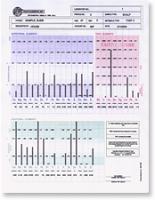Iron To Copper Ratio
Iron To Copper Ratio in Hair Testing
Order a Hair Tissue Mineral Analysis – Hair Test Here
The iron to copper ratio ( Fe/Cu) is specifically coined as the “Infection Ratio”.
This ratio provides insights on the state of one’s immune system and how resilient it can be to potential infections.
A high ratio typically signifies a bacterial infection.
A Lower ratio is correlated to viral infections.
The idea Iron to Copper Ratio is .9
- Iron is a mineral that is utilized in every cell in the body and is a component in hemoglobin which is.
- Iron in itself has been shown to feed infections, parasites and other organelles.
- Copper is required for hemoglobin synthesis and is multifactorial in supporting the body through the electron transport chain, the immune system, energy production and neurotransmitter synthesis.
- Copper transport requires strong adrenal function and clearance depends on bile.
- Usually higher copper levels are correlated more to potential infections than low because copper is connected to estrogen, and higher estrogen levels can feed growths.
- A lower ratio can also indicate thyroid problems.
- Other key markers to confirm an infection are low sodium to potassium (Na/K ratio) and below a 1, it’s a sign of a suppressed immune system.
A High Iron to Copper Ratio (Fe/Cu)
- A high Fe/Cu ratio leads to an increase in free radical production, specifically through lipid peroxidation that can damage our mitochondria and damage certain enzymes like superoxide dismutase.
- For those unaware, lipid peroxidation is when oxidants (the opposite of antioxidants) like free radicals, attack lipids containing carbon-carbon double bonds, like polyunsaturated fatty acids (PUFAS).
- This is dangerous because these fats are very unstable in our bodies and can feed into this inflammation.
- That enzyme superoxide dismutase is the first detoxification and most powerful enzyme in the cell for it acts as a component of first line defense system against reactive oxygen species.
- Sometimes the ratio is high just because copper is low, but it can also signify iron overload which must be reviewed in accordance to other ratios and mineral statuses.
- An high Fe/Cu ratio could also be connected to bacterial infections, as mentioned before, like an overgrowth in bacteria or even parasites.
A Low Iron to Copper Ratio (Fe/Cu)
- A low Fe/Cu ratio is associated more with viral infections like Epstein-Barr, Cytomegalovirus, influenza and others.
- A low Fe/Cu ratio is also a sign of low thyroid function which is the main driver to our metabolism.
- A slow functioning metabolism, this is a sign of a lowered immune system leaving one susceptible to things that typically wouldn’t be an issue.
- High elevation in copper will cause a low ratio which is is typically a sign of adrenal or liver stress.
- In order for copper to be utilized properly be “bioavailable” we need adequate adrenal and liver function to produce the protein ceruloplasmin to prevent iron deficiency, because copper helps the body utilize iron.


